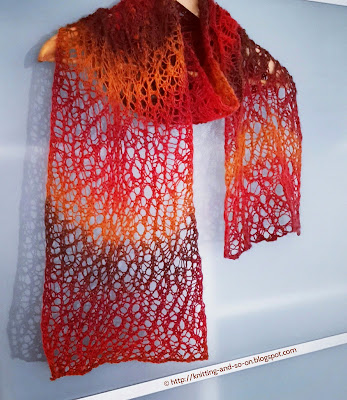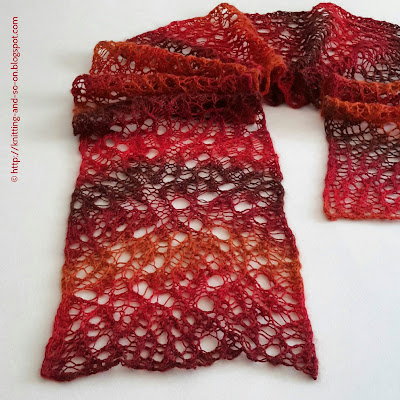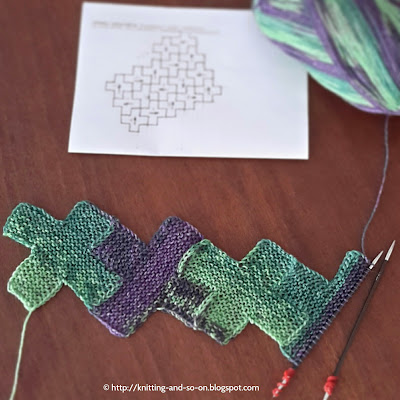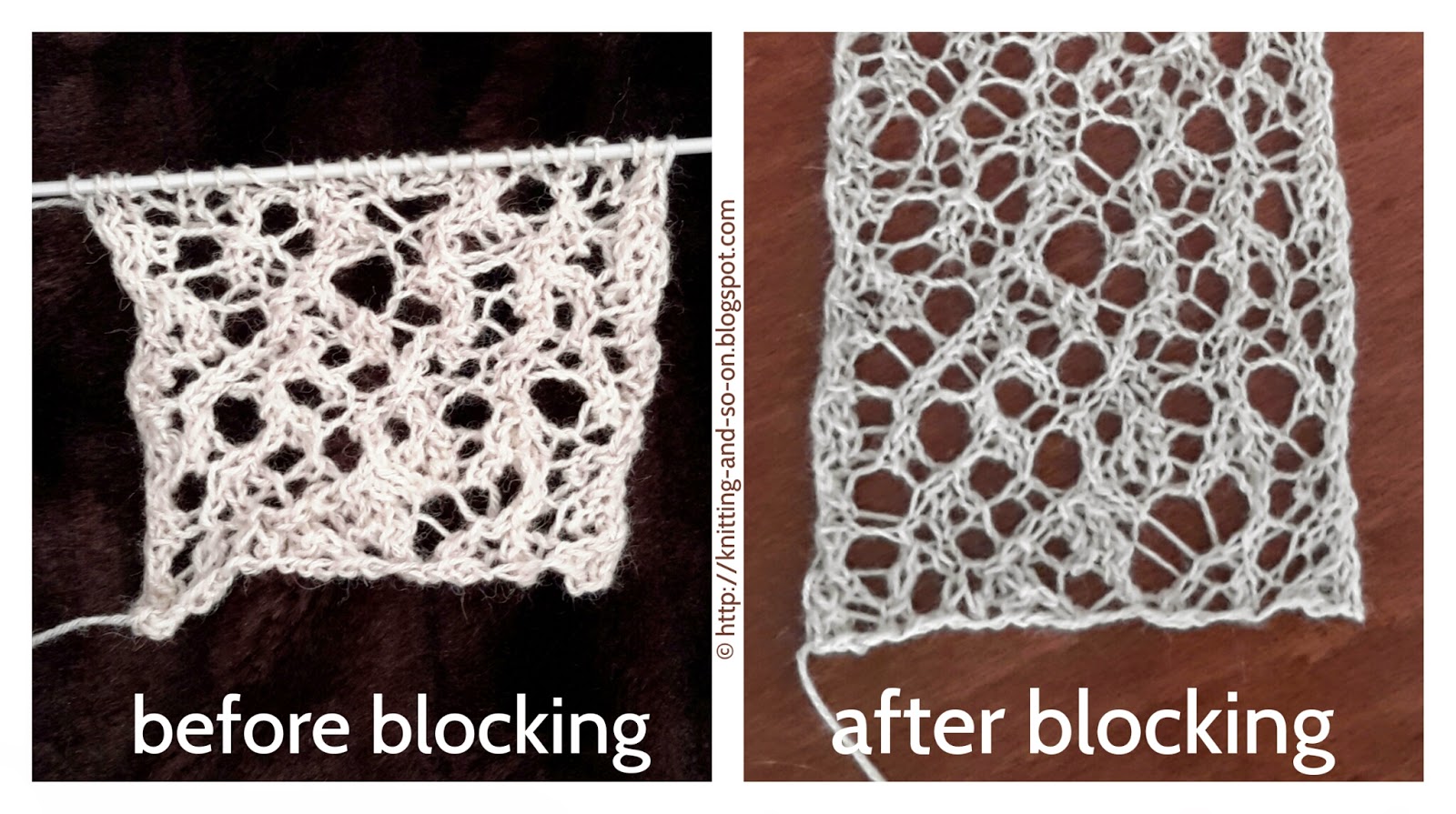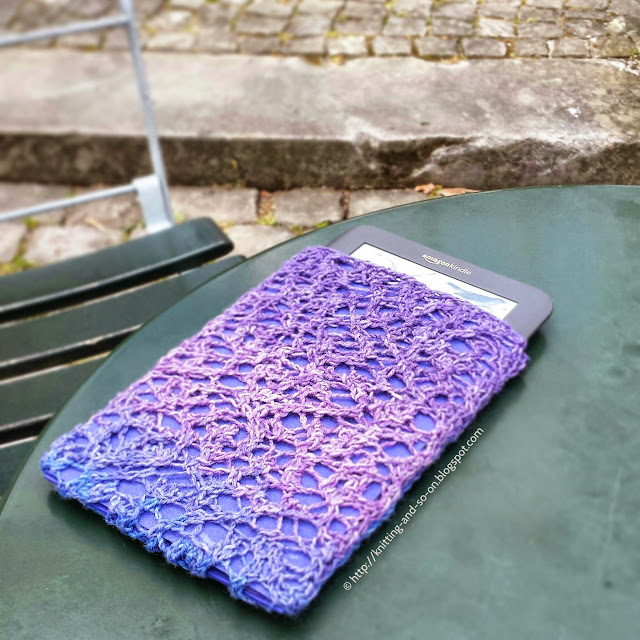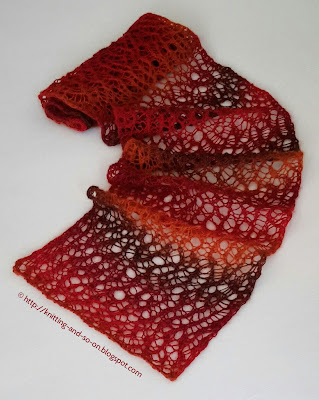 After knitting a few e-book sleeves in a random lace technique (see blogpost here), I decided that this could be explored a bit further and with a bigger project - a lacy scarf for summer.
After knitting a few e-book sleeves in a random lace technique (see blogpost here), I decided that this could be explored a bit further and with a bigger project - a lacy scarf for summer.This tutorial explains how to knit a scarf in the random lace technique. The result is a beautiful and unique piece of lace to wear on summer evenings.
Please note that this is not a pattern in the classic sense with detailed stitch by stitch and row by row sequences, but a set of instructions and tips that allow you to knit a scarf and achieve a similar result.


This work by Knitting and so on is licensed under a Creative Commons Attribution-NonCommercial-ShareAlike 4.0 International License.
Tweet
What do you need?
- Some yarn that blocks well, i.e. yarn with a high percentage of wool. I recommend using fingering weight or lighter yarn and knitting needles that are slightly bigger than what your yarn calls for.
I used about 100 grams fingering weight yarn and 3.75mm needles.
Since this is meant to be worn in summer I recommend to use anything between lace and sport weight. - The ability to count - and the patience to count your stitches again and again. Since everything looks quite similar while you're knitting it, it can be a bit of a boring project ... if you need something to give you instant gratification, this project might not be the right one for you. Furthermore, you really need to concentrate or to recount really often - so it's not a project to take to your local Stich'n'Bitch.
- The stamina to go on knitting a piece even though it will look really strange and crumpled while you're knitting it ... but it will miraculously turn beautiful when it's on the blocking board.
Stitches that you should know
I've linked to a few YouTube videos (not mine!) that show how to knit the following stitches.
For RS I used these stitches (stitches with a knit-look)
- k2tog (right-leaning decrease): https://youtu.be/ptZsAT770i8
- ssk (left-leaning decrease): https://youtu.be/RGwcYW3GG3M
- centered double decrease (or sl2tog, k1, p2sso): https://youtu.be/en3Yq2er4RI
- yo (increase): https://youtu.be/3QbFhh8u4L8
- yo twice (double increase): https://youtu.be/8NEAw0qtR70
- k yo k into one stitch: https://youtu.be/yAQxguVIRYY
- p2tog (looks like a right-leaning decrease on RS): https://youtu.be/M7RtzEDw6Xc
- p2togtbl (looks like a left-leaning decrease on RS): https://youtu.be/aLI4_u3T9Fo
- p3tog (double decrease): https://youtu.be/6ob7wn18MJI
- yo (increase on the purl side): https://youtu.be/_6zqcAJtORY
- yo twice (double increase on the purl side)
How to Knit the Scarf
CO50 sts and start with a WS row.
Start any WS row by slipping the first stitch purlwise and any RS row by slipping the first stitch knitwise. This will give a nice regular edge
On WS knit the stitches at random that I have listed under WS of the "Stitches that you should know" section - similarly, on RS knit the stitches at random that I have listed under RS of that section.
It is important to make sure that at the end of the row, you have the same number of stitches than you had at the beginnig (50 sts).
- I counted only the increases and decreases, i.e. starting from zero, adding one for each increase and substracting one for each decrease ... and finishing the row with a total of zero. But even this is a concentration exercise ...
- If you want a neater pattern, do one increase and corresponding decrease next to each other. For a more organic or slanted look, do a few increases and only then the necessary decreases. I would advise, however, not to do this too much, since then your piece will be askew.
- To make the pattern as holey as in the pictures, I usually made 10 to 15 yo's per row (and the corresponding number of decreases).
- I guess it is important to not overthink this technique, i.e. just to try making increases and decreases without any plan - and let yourself be surprised by the outcome.
- It might be a good idea to try this technique on a smaller object, such as a doily (or a sleeve for your e-book)
Go on knitting until the scarf has the desired length, then bind off loosely.
Please note, that the scarf will grow on the blocking board.
Weave in ends and block! (Blocking is really important here.)
Motivation Tip:
While knitting the piece you don't actually see your progress. You can measure it with a tape measure but you don't see it in the number of repeats or anything visible or easily countable. This can be a bit frustrating (... it certainly was for me). To keep myself motivated, when I started for the day I would put in a stitch marker (safety pin) to mark my starting point so that I could easily see my progress for the day.
This blogpost was featured at Oombawka Design Link & Share Wednesday - Link Party 93:



